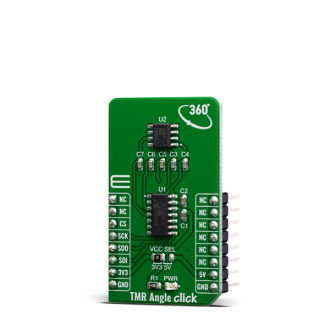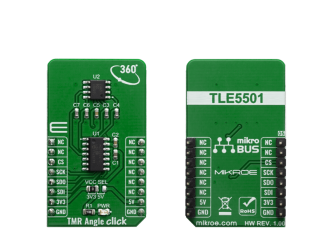
We strongly encourage users to use Package manager for sharing their code on Libstock website, because it boosts your efficiency and leaves the end user with no room for error. [more info]

Rating:
Author: MIKROE
Last Updated: 2019-10-15
Package Version: 1.0.0.0
mikroSDK Library: 1.0.0.0
Category: Motion
Downloaded: 3880 times
Not followed.
License: MIT license
TMR Angle Click is a Click board perfectly suited for developing applications that range from steering angle applications with the highest functional safety requirements to motors for wipers, pumps and actuators and electric motors in general.
Do you want to subscribe in order to receive notifications regarding "TMR Angle click" changes.
Do you want to unsubscribe in order to stop receiving notifications regarding "TMR Angle click" changes.
Do you want to report abuse regarding "TMR Angle click".


Library Description
The library covers all the necessary functions to control TMR Angle click board. A library performs a standard SPI interface communication.
Key functions:
void tmrangle_initSensorData() - Read and stores parameters data function.void tmrangle_calibrationFindParam( tmrangle_calib_data_t *calibParam ) - Get new calibration rotation parameters function.float tmrangle_getCalibAngle( tmrangle_calib_data_t *calibParam ) - Calculate the calibrated angle ( degree ) function.Examples description
The application is composed of three sections :
void applicationTask()
{
tmrangle_initSensorData();
tmrangle_initCalibData( &calibrationStoreParams, _TMRANGLE_MAX_DIFF_SIN, _TMRANGLE_MAX_DIFF_COS, _TMRANGLE_MIN_DIFF_SIN, _TMRANGLE_MIN_DIFF_COS, _TMRANGLE_SIN_45, _TMRANGLE_COS_45, _TMRANGLE_SIN_135, _TMRANGLE_COS_135 );
tmrangle_calibrationFindParam( &calibrationStoreParams );
angle = tmrangle_getCalibAngle( &calibrationStoreParams );
FloatToStr( angle, logText );
mikrobus_logWrite( " Angle is ", _LOG_TEXT );
mikrobus_logWrite( logText, _LOG_TEXT );
mikrobus_logWrite( degCel, _LOG_LINE );
mikrobus_logWrite( "----------------------", _LOG_LINE );
Delay_1sec();
}
Other mikroE Libraries used in the example:
Additional notes and informations
Depending on the development board you are using, you may need USB UART click, USB UART 2 click or RS232 click to connect to your PC, for development systems with no UART to USB interface available on the board. The terminal available in all MikroElektronika compilers, or any other terminal application of your choice, can be used to read the message.